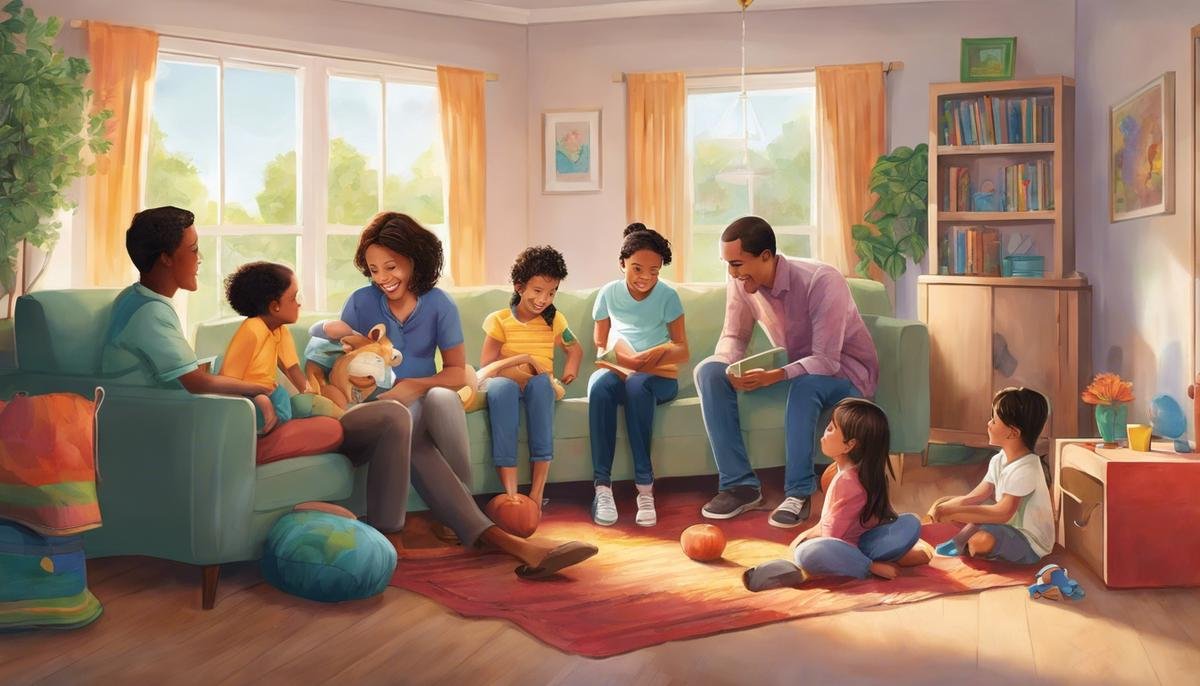
Welcome to a journey of discovery and understanding about autism spectrum disorder (ASD) and the associated safety risks it presents. Within the rich tapestry of human diversity, individuals on the autism spectrum experience the world through a unique lens that shapes their perceptions, interactions, and behaviors. Our quest delves into how these unique characteristics, from sensory sensitivities and communication difficulties to the inclination to wander, can influence safety both at home and in public spaces. Through education and insight, we aim to empower families and communities to create nurturing environments that prioritize the well-being and safety of autistic individuals. By walking this path together, we enhance our collective ability to make a meaningful difference in the lives touched by autism.
Understanding Autism and Associated Safety Risks
Guarding Our Treasures: Understanding Safety for Autistic Children
Welcoming a child with autism into your family tapestry means embracing a unique set of joys, challenges, and responsibilities – particularly when it comes to safety. While every parent has safety at the top of their priority list, for those with autistic children, this concern often wears a different set of colors. Let’s unwrap why safety is such a distinct concern for these incredible kids and explore ways to foster a secure environment that supports their flourishing.
Many autistic children have distinctive sensory sensitivities, which can either heighten or dull their perception of danger. A child who is hypersensitive might find the everyday hubbub of life overwhelmingly scary, causing them to shy away or even bolt in fear from situations that seem harmless to others. On the flip side, a child with reduced sensitivity may not recognize hazards such as hot temperatures or sharp objects, making them more vulnerable to accidents.
Communication can also weave a complex pattern in the safety tapestry. Some autistic children may have limited verbal skills, making it a challenge for them to express their needs or alert someone when they’re in danger. Others might take words very literally, so phrases like “it’s raining cats and dogs” can be confusing, and subtle cues or instructions might be missed altogether. This can make teaching safety concepts a craft that requires patience and creativity.
Wandering, known as elopement in clinical terms, rings a particular alarm bell for parents of autistic children. The draw of a special interest or the need to escape an overwhelming situation can lead to a child slipping away unnoticed. The statistics suggest parents aren’t just being overprotective; children with autism are four times more likely to wander than their neurotypical siblings.
Creating a family fortress doesn’t have to feel like a siege. Start by tailoring the living space with locking systems and alarms on doors and windows. Consider employing non-verbal tools like ID bracelets and tracking devices for extra security. For the crafty guardian, using picture charts and social stories can help in teaching safety rules in a clear, visual way that resonates with an autistic child.
Lastly, do not underestimate the power of a tight-knit community. Rally the neighbors, school staff, and family friends to be part of the safety net. Ensuring they understand the unique needs and behaviors associated with autism can turn them from onlookers into active guardians.
Securing the safety of an autistic child calls for a crafted approach, with a mix of preemptive strategies, clear communication, and a supportive community. Embrace this journey with love and foresight, creating a sanctuary where every family member can thrive.

Creating a Safe Home Environment
Creating a Sanctuary: Autism-Proofing Your Home for Enhanced Safety
When it comes to autism-proofing a home, there’s no one-size-fits-all solution. But with a sprinkle of love and a dash of ingenuity, every family can create a safe, nurturing environment that caters to the unique needs of a child with autism.
First things first, have a look around and think about creating clear, defined spaces within the home. Children with autism thrive on routine and structure, so a well-organized space with designated areas for play, sleep, and quiet time can do wonders to reduce anxiety and prevent meltdowns. Visual cues such as color coding and labels can help those with autism navigate these spaces with greater ease.
The next layer of safety in your home sweet home deals with sensory-friendly design. You know those harsh overhead lights and unpredictable sound echos that even sometimes get on your last nerve? Imagine how much more intense they can be for someone with sensory sensitivities! Opt for soft, natural lighting and consider acoustic treatments or background white noise machines to help muffle startling sounds. Also, cozy corners with pillows or bean bags serve as safe havens for sensory breaks.
Let’s talk safety through adaptation. Sharp corners and edges can sometimes be a haven for bumps and bruises. Why not babyproof not just for your toddlers but for all your kiddos? Those nifty corner guards and furniture padding serve just as well to protect your child who may have difficulty with spatial awareness. Don’t stop there; securing heavy furniture and TVs to the wall is an easy win to prevent accidents.
In the spirit of prevention, take a moment to consider potential hazards. Is there a swimming pool or a busy street nearby? Safety fences and window guards should be top of the list to safeguard against these external risks. Inside, ensure that all chemicals, medications, and sharp tools are locked away to prevent any mishaps.
Communication is key, and for non-verbal children, this could mean alternative strategies for expressing needs or indicating distress. Visual aids like emergency flashcards or mobile apps designed for communication can empower a child to signal for help even when words are hard to come by.
Lastly, fostering independence is a beautiful journey. Look for opportunities within your home to teach self-help skills in a safe and controlled environment. Simple tasks like organizing a drawer or putting away groceries can build confidence and autonomy. Let’s set the stage for success with labels, step-by-step checklists, and adaptive tools that make these tasks accessible.
Every home can be transformed into a sanctuary where safety and peace of mind are woven into the walls and the warm fabric of family life. It takes heart, a bit of creativity, and an ongoing commitment to learning and adapting to the ever-changing needs of a child with autism. Create, adjust, embrace, and watch your loved ones flourish in the comfort of a home that’s been autism-proofed with love.

Safety in Public Places and During Activities
When venturing into public spaces, keeping autistic children safe can feel like a full-time job. Preparation is key. Always have a game plan before heading out. This includes choosing the time of day carefully, when it is less crowded and overwhelming for children with heightened sensory processing.
Practice safety scenarios at home. Role-playing can be a fun and effective way to teach children what to do if they become separated from their caregiver. This includes identifying a safe person to ask for help, like a police officer or store employee wearing a recognizable uniform.
Engage in consistent, positive reinforcement. Encourage and reward children when they follow safety rules. Positive feedback reinforces good habits and certifies that they understand what’s expected of them.
Keep a current photo on hand at all times. In the instance a child does wander away, having a recent photo will be invaluable to first responders helping in the search.
Cultivate a network of safety ambassadors. When participating in community events, speak with organizers about your child’s needs. Enlist their help to keep an extra watchful eye on your child.
While it’s important to encourage children to explore and engage with the world, a responsible adult should maintain a close presence, especially if the child is known to run off suddenly.
Remember, each child is unique and what works for one family might be different for another. Continuously adapt these strategies to fit the evolving needs of the child.
In conclusion, keeping autistic children safe in public extends beyond physical measures. It encompasses preparation, education, consistent practice, and community awareness — all essential ingredients to nourish a safe and inclusive environment for our extraordinary children to flourish in.

Emergency Preparedness and Intervention
When venturing into public spaces with an autistic child, the unpredictability of the environment can be challenging. It’s key to choose times when locations are less crowded and overwhelming. Before stepping out, engaging in role-play or practicing safety scenarios can empower children with the knowledge of what to do in an emergency.
At home, parents should identify and discuss what a safe person looks like—perhaps a uniformed officer or an employee with a name tag—and instruct children how to seek help. It’s also beneficial to rehearse key personal information if the child is verbal or carry identifying items in case they are needed.
Consistent positive reinforcement shapes behavior, so recognizing and celebrating when a child follows safety instructions is crucial. These moments bolster confidence and consolidate learning.
Unexpected situations can arise, and having a current photo of the child is always a smart move. Should the child wander, this can be an invaluable tool in aiding a swift and safe recovery.
It takes a village—and creating a network of safety ambassadors enriches this community. Informing trusted neighbors, local businesses, and frequent visitors about the child’s needs ensures a watchful eye is ever present.
Especially in public, maintaining a close presence is essential. Children with autism might not recognize danger or hesitate to wander. Proximity allows for swift intervention if situations deviate from the plan.
Each child is wonderfully unique, which means safety strategies must be tailored. A technique that works brilliantly for one child might not resonate with another, so individualization is key to effective preparation.
Above all, nurturing a safe and inclusive environment for autistic children extends beyond the family unit. It’s a collective effort involving everyone from educators and friends to strangers in public spaces. Advocacy and awareness pave the way for a kinder, gentler world that embraces all of our kids, just as they are. Together, preparedness and compassion can create the harmonious balance every family seeks in the beautiful, complicated dance of raising a child with autism.

Building a Supportive Community
Understanding the Importance of Emergency Preparedness and First Responder Training for Autism Safety
When it comes to safeguarding our children, there’s an area that is absolutely crucial: emergency preparedness and training first responders about autism. Parents and caregivers know that autistic children may often have distinctive reactions to emergencies, and it’s vitally important that first responders are trained to recognize and adapt to the needs of autistic individuals in crisis situations.
First off, one major step towards autism safety is the custom training of police officers, firefighters, and EMTs. This training should focus on the unique ways autistic individuals may respond to emergencies, such as avoiding eye contact, being non-responsive to verbal commands, or having a meltdown due to the intense stress of the situation. With proper training, first responders can approach autistic individuals in a way that is both comforting and effective, decreasing the chances of a situation escalating.
Moreover, emergency drills at schools and community centers should incorporate scenarios with autism-specific considerations. These drills play an invaluable role in preparing autistic children for emergencies in a controlled setting where they can learn and practice the appropriate responses.
Community preparedness is also pivotal. Organizing autism safety awareness events can be so enriching, not just for extending knowledge but also for fostering empathy within the neighborhood. Sharing stories, distributing informational brochures, or even inviting guest speakers can make all the difference in creating an autism-aware community.
Furthermore, consider partnerships with local organizations to create safety programs tailored to autistic individuals. For example, some communities establish voluntary registries where families can provide critical information about autistic children. This can include communication preferences, de-escalation techniques, or emergency contact details, ensuring that first responders have access to vital information in advance.
Let’s not forget the power of technology, too. Mobile applications designed for emergency communication can be an asset for autistic individuals who are verbal or have limited speech. These tools offer a quick and effective way for them to communicate their needs and for caregivers to locate them if they wander.
Another practice that can go a long way is developing ‘Autism Emergency Cards’. These personalized cards contain essential information and are meant to be carried by autistic individuals. They act as an immediate point of reference for first responders during an emergency.
Lastly, it’s about bringing all these pieces together – from preparing homes and public spaces to training and community awareness; these are components of a solid safety network. A community that supports its autistic members is one that recognizes the diversity of its residents and dedicates itself to protecting all its children with equal measure.
Safety for children with autism is everyone’s responsibility. When a community comes together in understanding, education, and action, it creates an environment that is not only safer for autistic individuals but also more inclusive and compassionate for all its members. Together, let’s pledge to make safety a priority and ensure our children have the nurturing environment they need to thrive.

Embracing the full scope of autism awareness and safety is not a mere act of caution but a loving commitment to the well-being of those on the autism spectrum. Through the shared wisdom on securing home environments, navigating public spaces, preparing for emergencies, and fostering community support, we lay a foundation for a world that is not only safer but also more understanding and inclusive. As we weave these strands of knowledge into the fabric of our daily lives, our communities become stronger and more resilient—refuge against the uncertainty and a beacon of hope for every individual on the autism spectrum to live a life without limits.




